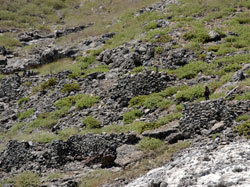
Cultural Feature: Agricultural Terraces on Nihoa

Terracing on Nihoa, including agricultural terraces, house foundations, and heiau. Photo Credit: David Boynton
Nihoa is the eastern most of the Northwestern Hawaiian islands. It is a "high island," meaning that it has a basalt rock substrate exposed, and some soil. Agricultural terraces on Nihoa thought to date between the 13th and 15th centuries provide evidence for permanent habitation of the island despite its small size (0.69 square kilometers, or 171 acres). Inhabitation of Nihoa ceased around the 18th century, but when it was inhabited these terraces were used to grow dry-land crops like dry-land taro or sweet potato that may have supported as many as 100 people. Agricultural production on island was necessarily limited by available fresh water, and steep terrain. During an early archaeology expedition to Nihoa in 1924 - part of the Tanager Expedition - Bishop Museum Archaeologist Kenneth Emory estimated that about 7.7 percent of the island had been terraced for dry-land crop production.
Click Here to learn more about the cultural history of the Northwestern Hawaiian Islands.
Click Here to learn more about Papahānaumokuākea's archaeological resources.
